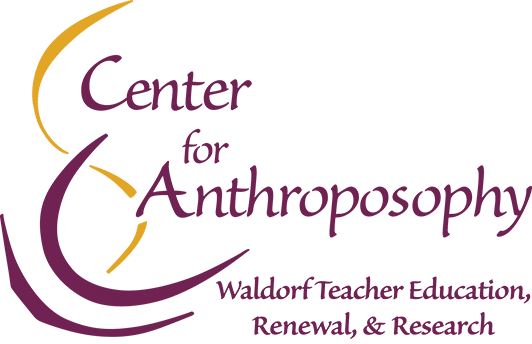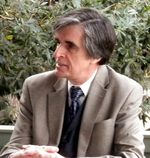
Just 100 years ago, Rudolf Steiner and Marie von Sivers, the woman who would become his second wife, stood on a hill overlooking the tiny village of Dornach in the northwest quadrant of Switzerland and contemplated the founding of a new center for the study and practice of anthroposophy. Within a decade Steiner’s first Goetheanum, a unique structure crowned by two interlocking wooden domes, had risen on this hill and, on the last night of 1922, burned to the ground.
Undeterred, Steiner immediately began designing new sculptural models for a second and quite different edifice, this one made from what was then a revolutionary building material: molded concrete. Steiner would not live to see this building completed, but today it still stands as a leading example of a new sculptural form of architecture.
In this autumn issue of our seasonal newsletter Center & Periphery, Milan Daler retraces the steep winding path to the Goetheanum to report on his first experience of this magnificent structure, as well as on a lecture conference he attended there at Michaelmas. Further afield in this issue, we uncover what Steiner said––or did not say––about education during one of his many lecture trips to England, and we re-examine what he said about the future of technology, especially in the West. We also bring you summaries of our own conferences and courses during this year: past, present, and future.
Enjoy the voyages!
Douglas Gerwin, Director
Center for Anthroposophy
In this Issue
Dateline Dornach, Switzerland: Distant Dream into Breath-Taking Reality
Five perspectives on the Goetheanum, including one after the first wooden version burned to the ground
Milan Daler, Administrator of the Center for Anthroposophy, captures in word and image his first impressions of the Goetheanum.
Whoever encounters the work of Rudolf Steiner will soon become aware of the Goetheanum –– world-wide center and earthly home of anthroposophy in Dornach, Switzerland. The original building, a mostly wooden structure designed by Rudolf Steiner, arose between 1913 and 1920 at the hand of workers who flocked to Dornach from countries on both sides of World War I. This miracle of a building was completely destroyed by arsonist’s fire during the New Year’s night 1922/23.
Deeply wounded but undeterred, Rudolf Steiner set about envisioning and designing a second Goetheanum made of the radically new medium of reinforced concrete. Apart from the issue of fire prevention, he saw the opportunities it offered for unrestricted design. The new building was built between 1925-1928 entirely on the basis of his model, but Rudolf Steiner himself did not live to see it completed, succumbing to illness on March 30, 1925 in his study, which was housed the carpentry shop, or “Schreinerei”, directly adjacent to the construction site of the Goetheanum.
Right from my first encounter with anthroposophy (facilitated 14 years ago by my future wife, Jennifer) and subsequent study of Rudolf Steiner’s work, I have nurtured the dream that one day I would visit the Goetheanum, to explore this magnificent building inside and out, to walk the grounds, to breath the surrounding air.
Earlier this fall, with support of my colleagues at the Center for Anthroposophy, this dream came true, and I was able to attend the annual Michaelmas conference organized by the Collegium of the School of Spiritual Science. As I walked up the Dornach hill for the first time, the magnificent building¬¬––to say nothing of the steepness of the hill––literally took my breath away. I paused for a moment to take my first picture of this imposing edifice before approaching the giant metal and glass doors facing the rolling hills to the west. To my surprise, these massive doors swung open easily and I could see the hustle and a bustle of pre-conference registrations and, at the center of it all, a beautiful white sculpture of Michael blessing humanity.
The walls of the ground floor reception area are covered by a photo exhibition dedicated to a hundred years of eurythmy and featuring the life stories of the founding eurythmists. Two wide and gently curved stairways––one on each side of the foyer––lead the visitor to a second floor and the offices of the Vorstand (the Presidium of the Anthroposophical Society) members and the beautifully lazured back hallway with an exhibition of paintings by anthroposophical painter Ninetta Sombart. From there more stairways lead up to a monumental entryway to the Great Hall where the largest conferences are held, eurythmy is performed, and Rudolf Steiner’s mystery plays and unabridged productions of Goethe’s Faust are regularly staged.
The hall itself has an almost overwhelming effect on a receptive visitor. The imposing pillars, the beauty of the ceiling painting, the warm colors gently flooding the space through colorful etched-glass windows, the organ loft, the stage. And not to forget the acoustics! How is it possible that, in a concrete structure, the human voice and sounds of music carry so majestically and without echo? There is a “golden” spot up in the organ loft, from which a speaker’s voice resounds like voice of heaven itself.
At the top of another staircase in the south wing of this building can be found another high-ceilinged room close to the sweeping roof of the building. Here is housed Rudolf Steiner’s 30-foot high sculpture The Representative of Humanity. The statue, made of slats of wood glued together, depicts the Christ Being holding the influences of Lucifer and Ahriman, the two forms of evil, in balance and at bay. There are benches in the room where one can just sit and meditate.
Meals for the conference I was attending were served in the “Schreinerei”, the famous carpentry shop which survived the fire of 1922 and where the “Christmas Conference”–– the re-founding of the Anthroposophical Society––was held in 1923. When I first entered the Schreinerei and noticed how worn the floorboards were, it dawned on me that these must be the very same boards on which Rudolf Steiner himself had walked so many times –– and with him the founding personalities of the worldwide anthroposophical movement.
In this very same building is a small and sparsely decorated room, usually locked and not available for public viewing, but now, on the occasion of the Michaelmas conference, opened for one afternoon. This is Rudolf Steiner’s studio, a simple rough-hewn room in which he spent the last months of his life mostly bedridden, and where on March 30, 1925 he passed away. Here too were a couple of benches where one could sit and contemplate the magnitude of Rudolf Steiner’s legacy for humanity.
The landscape surrounding the Goetheanum is also stunningly beautiful, with its rolling hills and numerous anthroposophically inspired buildings, playfully called “The Colony”. The elaborate, many-angled roofs would make an average roofer’s hair stand on end. Just imagining how they figured out the correct angles made my head spin.
There is also life “behind the Goetheanum” in the form of a working bio-dynamic farm with a herd of goats peacefully grazing in their hold. Streets of Dornach and Arlesheim seemed quiet by comparison to the US, since almost everybody––from children to well-dressed businessmen and elders––was riding a bicycle. Bicycle shelters were everywhere!
Since it is impossible to do justice to this hub of anthroposophy in so few words, I can only hope that every reader of our newsletter Center & Periphery has the opportunity to experience the heart center of anthroposophy and the architectural wonder of the Goetheanum.
Dateline Ilkley, England: Der Doktor Hat (Nicht?) Gesagt
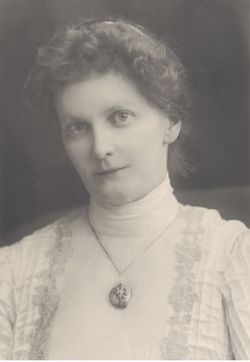 One of statements most often attributed to Rudolf Steiner turns out to have a surprising origin and history. The investigative sleuth for Center & Periphery reports his findings.
One of statements most often attributed to Rudolf Steiner turns out to have a surprising origin and history. The investigative sleuth for Center & Periphery reports his findings.
How often one finds in a Waldorf school brochure or flyer this celebrated sentence:
“Our highest endeavour must be to develop free human beings who are able of themselves to impart purpose and direction to their lives.”
In response to a recent question, we took on the task of tracking down the original German formulation of this statement. An Internet search established that this quote comes from A Modern Art of Education, the title given to a translated cycle of lectures that Rudolf Steiner gave between the 5th and 17th of August, 1923 in the small Yorkshire town of Ilkley in the far northeast of England.
In the course of his life, Steiner made ten visits to England, and although he understood (and could even speak) English, he opted to deliver these lectures at Ilkley––as he did on other occasions––in his native Austrian, with George Adams then freely rendering them into English. Under the terms agreed by these two men, Steiner would speak for 40 minutes to an hour and Adams would then summarize Steiner’s remarks in roughly half that time.
The first published edition of these lectures in English appeared five years later and was subsequently twice revised and expanded. In German the lectures were published as No. 307 in Steiner’s complete edition under the title Gegenwaertiges Geistesleben und Erziehung (“The Spiritual Life of the Present and Education”).
The famous quote in question appears on the final page of what turns out to be a foreword to the English edition. At the bottom of the page the author of this foreword is identified as “Marie Steiner”. Based on this evidence, it would appear that the quote attributed to Rudolf Steiner actually comes from the pen of his wife.
The story is further complicated by the fact that the collection of these lectures in their original German contains no foreword at all, leaving open the question whether Marie Steiner wrote this foreword exclusively for the English edition, and if so, in which language she drafted it.
Whatever the original language of this passage, the upshot of this research is that Marie Steiner (who, as it happens, was in attendance at her husband’s lectures in Ilkley) is the author of one of the most popular formulations of the mission of Waldorf education: “Our highest endeavour must be to develop free human beings who are able of themselves to impart purpose and direction to their lives.”
Dateline Wilton, NH: New Line-up for Renewal Courses in 2013
Several new presenters will be joining the roster of faculty during the next round of week-long Renewal Courses. Karine Munk Finser, Coordinator of Renewal Courses, outlines prospects for a busy and stellar Summer 2013.
Preparations for our 14th year of Renewal Courses in Wilton, New Hampshire are well underway. Here is a sneak preview of the line-up for June and July 2013. More courses will be announced soon, so please check in with us often on our websi
Week 1: Sunday 23 June to Friday 28 June 2013
Christof Wiechert will return with a special focus on “Autism and Integrating Children” with a variety of needs in the Waldorf classroom in his advanced Child Studies for Educators course.
Margot Amrine and Elena Efimova are bringing “Russian Spiritualty: Intimations of a Future Epoch”. This course will include masterpieces of art, music, and literature.
Elizabeth Auer will help prepare 6th, 7th, and 8th grade teachers in a course entitled “Romans, Renaissance, and Revolutions: Academic Learning through Hands-on-Curricula for Grades 6, 7, and 8”. Teachers can enrich their specific grade doing mosaics, veiling, Japanese Sumi painting, clay modeling of the human head, geometric pastel drawing, and more.
Laura Summer will offer “Painting from the Face of God: Devotional Painting in the 21st Century”. Through color, we will reach for the divine and find a creative relationship to the path of love.
Frederick Amrine with Elena Efimova will bring a course on “The Threefold Social Organism: Rudolf Steiner as a Social Activist”. This seminar will not only help participants understand the living context and potential of this larger movement for social renewal but also allow them to envision further innovations that might grow from this seed.
Eleanor Winship will offer “Experiencing Music as a Path to the Spirit: Singing through the Grades”, a course that will support both music teachers and the daily life of the Waldorf classroom.
Wendy Bruneau has laid out an artistic and practical path for bringing Shakespeare to Adolescents: “Who Is It That Can Tell Me Who I Am?” This course will inspire High School drama teachers but upper elementary teachers may benefit from this rich guidance.
Lorey Johnson and Kati Manning are presenting “World Languages: Active Learning and Awakening the Intellect in Grades 4, 5, and 6”. All languages are welcomed!
Rudiger Janisch and Penelope Baring will bring an in-depth course entitled “From Meditative Work to Outer Deeds: A Path of Service through the General Anthroposophical Section and the First Class”.
Regine Kurek and Linda Larson will offer “The Book of Life: A Journey through Crisis and Turning Points”. This biography workshop includes eurythmy, painting, and drawing.
Peter Snow returns with a course entitled “The Teacher’s Greatest Tool: The Art of Storytelling in the Classroom”.
Week 2: Sunday 30 June to Friday 5 July 2013
Michaela Gloeckler brings us “Destiny in Health and Illness and the Development of Consciousness and Conscience”. This course will include daily tone eurythmy.
Janene Ping has chosen “Peacemaker Spirit: Honoring Native American Image through Puppetry Arts” as her theme. Participants will work artistically with the genii loci, the spirit of place.
Eugene Schwartz is offering “Severance, Storm, and Serenity: Grades 3, 4, and 5 in the Waldorf School Setting”.
Chuck Andrade, finally returning to Wilton, brings “Color, Value, Form: A Threefold Approach to Pictorial Imagery”.
Paul Matthews and Patrice Pinette will offer a poetry course, “With Grace and Gravity: Creative Writing in the Play of Opposites”, accompanied by Eurythmy and Spacial Dynamics.
Aonghus Gordon and Craftsmen are returning with “Thinking With Our Hands: Mastering Material; Mastering the Self”.
We are very much looking forward to welcoming you next summer. You are encouraged to sign up early, especially if you are seeking a single room!
Eurythmy Spring Valley will return to Wilton for a performance on July 3rd in the Pine Hill Auditorium. We can also tell you that Christof Wiechert, Eugene Schwartz, and Michaela Gloeckler will offer evening lectures, and there’ll be lovely music and great food!
We are looking forward to sharing Renewal with you.
Dateline New York, NY: Technology in Teaching
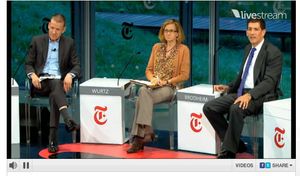 Amidst the breathless promises of what computers and smart boards bring to the classroom, questions persist about the role of technology in education. Patrice Maynard from AWSNA reports on a recent colloquium on this subject at the headquarters of The New York Times.
Amidst the breathless promises of what computers and smart boards bring to the classroom, questions persist about the role of technology in education. Patrice Maynard from AWSNA reports on a recent colloquium on this subject at the headquarters of The New York Times.
On September 13, 2012, Lucy Wurtz, from the Waldorf School of the Peninsula, was invited to speak at a New York Times-sponsored conference on education. Douglas Gerwin, Director of the Center for Anthroposophy and Co-Director of the Research Institute for Waldorf Education, and Patrice Maynard, Leader of Outreach and Development at the Association of Waldorf Schools of North America (AWSNA), also attended.
The conference, entitled “Schools for Tomorrow,” featured many noteworthy educational leaders and commentators: Linda Darling Hammond of Stanford University, Sharon Robinson of the American Association of Colleges for Teacher Education, Monty Neill of Fair Test, Herbert Ginsburg of Teachers College, Columbia University, and Dennis Wolcott, Chancellor of New York City’s Department of Education, to name a few. Moderators, all of them journalists from the New York Times, included Gerald Marzorati, David Brooks, Bill Keller, and Nick Kristof, among others.
In the midst of a heady mood of technology as a powerful answer to our educational questions, Lucy Wurtz, in her panel entitled, “Head to Head,” represented the very different approach Waldorf Education offers. She drew applause more than once from the audience of teachers, school principals, educational technology experts, and educational consultants.
After the event ended, many approached her to thank her for her courage in taking a stand on behalf of children, bringing in the arts and practical skills, and citing statistics about our children’s habits of hours in front of screens. The New York Times is to be commended for its active interest in creating such an open forum for educational debate and for the artistic and socially supportive design of the entire day’s event.
Dateline Amherst, MA: If E-Go Today, E-Gone Tomorrow
 It’s time to respond to a question posed in the spring issue of this newsletter concerning the role of technology in education. As editor of Center & Periphery, Douglas Gerwin picks up the thread.
It’s time to respond to a question posed in the spring issue of this newsletter concerning the role of technology in education. As editor of Center & Periphery, Douglas Gerwin picks up the thread.
Regular readers of this newsletter will recall that last spring I posed two questions about the role of technology in education –– and in society as a whole. The point was not to beat the drum about the perils of TV or computers or smart phones but rather to examine them as being tools or “prosthetics” for human skills and capabilities, recognizing that prosthetics are helpful when they assist a human skill or capability but harmful when they threaten to take it over.
In this context, I mentioned that Rudolf Steiner actually cautioned against banning tools of technology outright. In a lecture given shortly after the outbreak of World War I [“Technology and Art”, Dornach, 28 December 1914], he declared: “It would be the worst possible mistake to say that we should resist what technology has brought into modern life, that we should protect ourselves . . . by cutting ourselves off from modern life. In a certain sense this would be spiritual cowardice.” [emphasis added]
Instead, Steiner went on to say, the more we expose ourselves to technology (rather than flee from it), the more we need to strengthen in ourselves––for instance, through the arts––precisely those human capacities that technology mimics or supplements.
And so the two questions I posed in the spring issue of Center & Periphery were these:
- Which human skills does the computer mimic or supplement?
- At which age will children have developed these skills sufficiently so that the computer can assist rather than hijack them?
We received some helpful responses to these questions, from which the following observations can be distilled:
To the first question: It is tempting to think of the computer as a fancy calculator or stern grammarian, and for many people (myself included) this device does indeed serve these functions. But what makes the computer distinctive from other technological devices is its ability to simulate human experience. In fact, as one respondent suggested, we should rename the computer “the simulator” in recognition of the tremendous benefits that the computer has wrought in our culture, especially in the fields of engineering, medicine, and––yes––entertainment and even broadcasting.
Computer models allow us to test new engines, fly new airplanes, try out new drugs without even creating them in the physical world. Using virtual models, we are able to experiment with new designs and simulate their effects. By the same token, every weather map you see on the evening newscast and just about every vehicle or building you see get blown up in a scene of a so-called “action movie” these days is some kind of computer simulation. If you have remained seated in the cinema long enough for the end of the credits, you will know just how many people work on a film’s computerized “FX”.
So, what’s the problem with that? The problem is the same as for all examples of technology. It’s great when it supplements a skill you have already developed, and it’s not so great when it supplants it. If you have mastered some drawings of projective geometry, the computer can enhance your understanding and appreciation of this mind-bending subject through models of geometric forms set whirling in simulated motion. But in teaching this subject, I would never wish my students to work with these simulations until they had first achieved a measure of skill in making their own drawings. It’s the difference between listening to a recording of music you don’t know and listening to a recording in which a skilled soloist plays precisely the piece you have struggled for months to play for yourself. The recording is all the more thrilling if it supplements your own experience rather than replacing it.
There, then, is the first point: the computer supplies us with a virtual experience that can serve to supplement our actual, that is to say lived, experience. The mischief––including, I would suggest, the beginning of addiction––begins when the computer supplants it.
Virtual experience is of a different order of being than lived experience. It is like an advertisement for a loaf of bread: the promise––but not the delivery––of nourishment. If anything, the image will stir the craving but not, of itself, relieve it.
To the second question: If we can recognize the specific genius of the computer as being its ability to simulate human experience, then (at least in an abstract way) we have already answered the second question. The child will be ready to benefit from simulated experience to the degree it has already engaged in its own lived experience.
But here’s the rub: who is willing––or even able––to withhold the computer from children for that long? As one set of parents reported in response to our questions, the more they try to keep the computer from their children, the more they run after it. So we need an alternative approach.
Here’s one. Let’s ask a practical question: what are children not doing while engaged with the computer that otherwise they might be doing? Three things come to mind:
a. They are not moving
b. They are not creating their own mental pictures
c. They are not engaged in lived experience
Empirically, we know that children need to exercise all three of these capabilities if they are to enjoy a healthy physical, emotional, and spiritual life, both in childhood and later in adult life. In the context of Waldorf education, we know that all three of these exercises involve the child’s developing sense of self, or “I”. When the child’s “I” is engaged, the child will develop healthily; when the “I” is not engaged, the child will not mature.
Empirical studies show that the “I” is most engaged when the child is stirred to physical movement (especially in the pre-school years), when it is inspired to create mental pictures (especially during the grade school years), and when it is motivated to embrace self-directed lived experience (especially in high school and in the years that follow). To the degree, then, that children spend their time on the computer at the expense of exercising these three capacities, to this same degree their caretakers––that is, we as their parents and teachers––need to provide all the more opportunities to develop them.
A ratio of computer time to movement time; a ratio of computer time to mental creativity time; a ratio of virtual computer experience to lived experience needs to be calculated –– perhaps negotiated and modified, as the child gets older. The key point, though, is that movement, mental creativity, and lived experience are “front loaded”, so to speak. First the real, then the simulated, or e-real.
Otherwise, the child will run the risk of growing up without the full involvement of its “I” or ego. And when ego is treated as e-go, in time it will be e-gone.
Dateline Freeport, ME: Reflections on Foundation Studies from Maine to Florida
Barbara Richardson, Coordinator of Foundation Studies, reflects on her own entry into anthroposophy three decades ago and summarizes the reports of recent participants in the clusters of Foundation Studies sponsored by the Center for Anthroposophy.
Returning from my first visit to a Waldorf school, which included an impromptu interview for the teacher training course, I knew this was the education I had been seeking. I had with me two books by Rudolf Steiner; How to Know Higher Worlds and Education as a Social Problem (now Education as a Force for Social Change.) I devoured the six lectures in the latter book over the next couple of days, and emerged confirmed in my enthusiasm for Waldorf and the philosophy behind it. The first book, though, would stay with me through my travels over the next year and a half as I finished college and worked to save money for tuition. Now and then I would pick it up, read a few pages and, though they resonated with me, somehow my brain would turn to spaghetti and I could not hold onto the sentences…where did one end and the next begin? I clearly needed help!
I tried mightily to finish the book before the teacher training course started, but couldn’t manage it. I was thrilled to see that the year-long course was made up half of study/lecture/methods courses and half of art classes such as sculpture, handwork, painting, drawing, music, speech, and eurythmy. It was only after this rich and inspiring year that I was finally able to read How to Know Higher Worlds and begin my life-long study of it.
Perhaps in this story are buried the reasons why, 35 years later, I took on the task of Foundation Studies Coordinator at the Center for Anthroposophy!
And now, in the words of several Foundation Studies participants, you will receive a glimpse of the varied paths students have taken in Foundation Studies starting with their applications and comments along the way in course evaluations. (Comments from overall course evaluations will be the subject of the next issue’s article.)
From two board members:
As a parent of two children and chair of the Board of Trustees, I would like to gain a deeper understanding of Anthroposophy.
I am interested in learning about the fundamentals of my children’s education and more about the variety of knowledge that Steiner pursued. I believe it will help in my life.
From Waldorf alums:
I am a Waldorf graduate with a background in science and scientific research. I became interested in learning more about what happens “behind the curtain” in Waldorf education after having children of my own and taking them to a Waldorf playgroup. I would bring a unique perspective and a lot of enthusiasm for art and eurythmy.
I am a 2010 graduate of Waldorf education and would eventually like to become a Waldorf teacher.
I attended a Waldorf school 1st through 8th grades. I am now interested in becoming a Waldorf teacher. I grew up with many of Steiner’s philosophies and am interested in discovering their origins.
From current Waldorf teachers:
I have been teaching at this school for five years. I finished an intensive training last summer and I left the training with the strong feeling that I want to learn more. I am planning to pursue a Waldorf Teacher’s Certificate and this is a great opportunity for me. I am also excited to have this in our town. We will be able to build a strong community that supports the growth of Waldorf Education.
I began teaching at my current Waldorf School 12 years ago. At that time, I already had 18 years of experience teaching in other private schools. I have tremendous respect and admiration for the work done with the children through the Waldorf curriculum in conjunction with the aspirations and commitment of teachers and parents in our school community. Over the past 12 years, I have applied myself to becoming a better Waldorf teacher and colleague, with help from the observations and guidance of colleagues, and through the reading and study of texts by Rudolf Steiner and the practice of eurythmy and meditation. I have attended several Waldorf conferences and one-week workshops for teachers.
I am very interested in deepening my understanding of anthroposophy and human nature, and in studying alongside other interested people. I look forward to pursuing a complete program of Foundation Studies, with artistic experiences, which will help me and guide me in the work of self-development and spiritual growth.
From parents new to a Waldorf school:
I am interested in FS because I am interested in Waldorf Education. I am an early childhood educator myself. Since discovering Waldorf I knew this was what I wanted for my kids and for myself. Someday I would like to return to work, specifically, teaching Early Childhood in a Waldorf School.
As a parent of a Waldorf kindergartener, I want to understand the underpinnings of Waldorf education so I can support her, her class, and my family in her and our development. I bring an open mind and interest in Rudolf Steiner and his teachings.
I am a licensed psychotherapist and educator currently staying home with my four children. I came to the Waldorf school through my first born and am interested in expanding my knowledge and experience with anthroposophy for my own benefit, the benefit of my family and children and in hopes of pursuing a Waldorf teaching certificate in the future.
I have been interested in Rudolf Steiner since my initial discovery of him around 6 years ago, through my independent studies, but most especially since the birth of my child four years ago, when I first learned of Waldorf Education. My deepest instincts as a mother are affirmed and inspired by all that I have read of Rudolf Steiner’s recommendations. My child will begin nursery this fall and it feels like the perfect time to take the first steps of my journey towards that dream as well. My husband also hopes to participate in the Foundation Studies, so together we may move into this new phase of growth as we embrace Anthroposophy as a family.
From some home-school parents:
I am a life-long learner and a lover of knowledge and experience. Over 10 years ago I was a public school teacher, frustrated with the system, yet passionate about the learning experience and development of children. Then, seven years ago, I attended several events at a Waldorf school while pregnant with my first son. The information was transformational to my life. I am currently home-schooling with Waldorf based curriculum my 7, 4, and 2 year old sons. I have my enthusiasm and desire for higher understanding to offer to the class, as well as a load of humility as I begin a new journey with much to learn and unlearn.
Further comments from course evaluation forms:
“The study of Anthroposophy is basically transformation. Without knowing what the future holds, it’s important to be mindful and active in raising the whole child.”
“We covered an amazing amount of discussion within this broad topic, within the exact time allotted. Thoughtful coordination between artistic activities contributed to a very satisfying ‘whole’ experience. Wonderful instructors helped bring a dense and heavy topic in an easily digestible format.”
“ I found this presenter’s style wonderfully refreshing; not only did she present theory but also various realities as to how the theory is applied. My experience went from highly contemplative to hearty laughter! There was a wonderful blend of heart, soul and head conversation. I learn on many levels and the eurythmy really adds to the experience as well – it brings the lessons into my body at a level not available by any other means (that I know of anyway).”
“Small groups allow space for introverts to speak and for people to ask questions they are uncomfortable with in the larger group.”
After 6th session: “I feel so grateful to be exposed to this study and exploration. This was the first session when I really connected the dots from previous sessions to this one.”
Dateline Wilton NH: Where Are They Now?
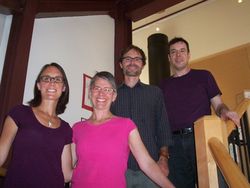 Among the four students who graduated this summer from CfA’s Waldorf High School Teacher Education Program (WHiSTEP), three are currently active in the classroom. Douglas Gerwin, Director of the Center and Chair of WHiSTEP, briefly outlines where they are working.
Among the four students who graduated this summer from CfA’s Waldorf High School Teacher Education Program (WHiSTEP), three are currently active in the classroom. Douglas Gerwin, Director of the Center and Chair of WHiSTEP, briefly outlines where they are working.
All but one of the Class of 2012 were already working in schools even before they completed their training this summer in the Center’s Waldorf High School Teacher Education Program (WHiSTEP). With the beginning of this school year, all of them are teaching or interning in schools dotted around the country:
- John Chambers: continuing his practicum in history and literature after interning with Meg Gorman last spring at the Santa Fe Waldorf School
- Mick Falconbridge: teaching physics and math at the Monadnock Waldorf School in Keene, NH
- Betsy Kabrick: teaching life sciences and math at the Shining Mountain Waldorf School in Boulder, CO
- Nellie Lovendusky: teaching physics and math at the Waldorf School of Saratoga Springs in Saratoga Springs, NY
Looking ahead to the summer of 2013, a new group of high school trainees is already forming, with specializations offered in
- Arts and art history
- English language and literature
- History and social sciences
- Life science and earth science
- Mathematics and computer studies
- Physics and chemistry
- Pedagogical eurythmy
For details, contact Douglas Gerwin, Director of the Center for Anthroposophy, at douglasgerwin@earthlink.net.
Dateline Wilton, NH: Highlights from CfA’s Annual Report
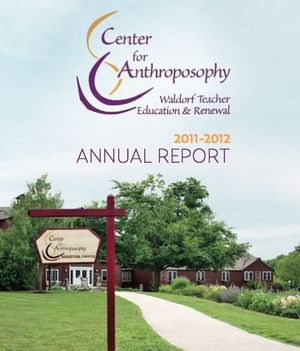 Under the banner “Coming of Age”, the Center for Anthroposophy’s Annual Report summarizes the achievements of past year, as well as of the previous two decades.
Under the banner “Coming of Age”, the Center for Anthroposophy’s Annual Report summarizes the achievements of past year, as well as of the previous two decades.
Ever since it became a full member of the Association of Waldorf School of North America (AWSNA) 21 years ago, the Center for Anthroposophy has submitted an annual summary of its activities to its fellow schools and institutes. This year, drawing on the theme “Coming of Age”, our annual report casts a brief look back over three seven-year periods of collaboration with other Waldorf institutions and schools.
Among the highlights are the inauguration of a record number of Foundation Studies clusters (separately reviewed in this issue of Center & Periphery) and reports on the summer offerings of Renewal Courses and the Waldorf High School Teacher Education Program.
The report also depicts details of income and expenditure for last year, demonstrating that the Center was able to balance its budget despite ongoing constraints in the world economy. For the first time, the annual report lists the names of donors to the Center’s annual giving appeal, with an acknowledgement of their continuing support and generosity.
Click here for a copy of the Center’s 2011-2012 Annual Report.
